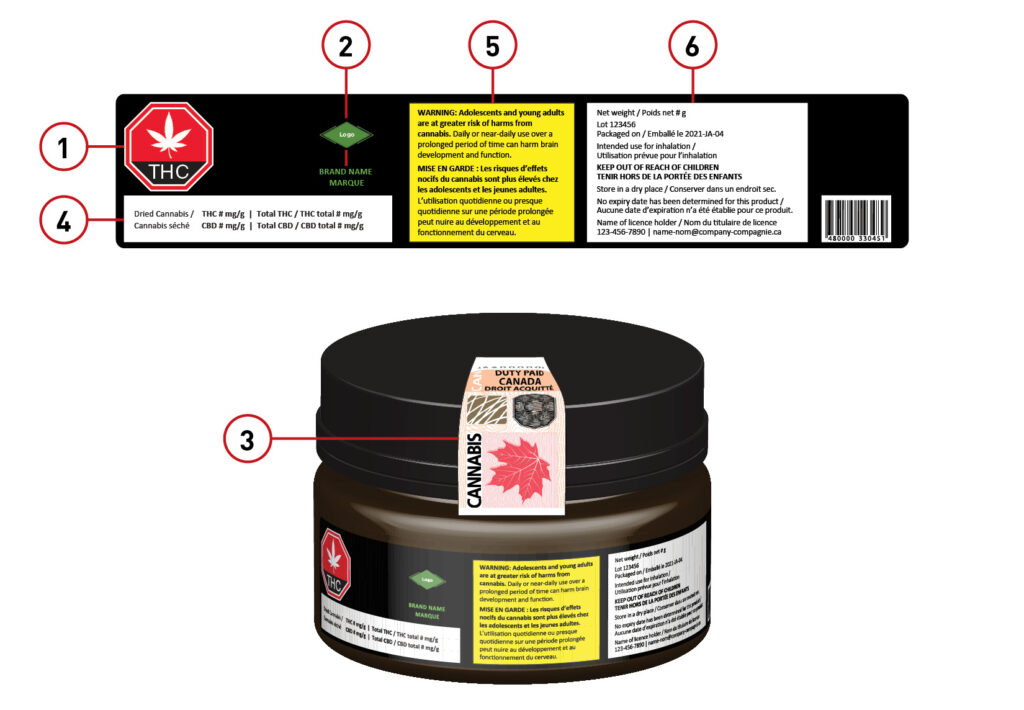Understanding Cannabis Labelling in Canada: A Guide for Patients and Healthcare Providers
Why Cannabis Labelling Matters in Canada
Cannabis labels are more than just fine print — they’re a vital safety tool. They tell patients and healthcare providers what’s in the product, how strong it is, and how to use it responsibly. In Canada, labels are regulated by Health Canada to ensure accuracy, compliance, and consumer protection.
Key Elements of a Cannabis Label in Canada
THC and CBD Content
Labels display both active (THC, CBD) and non-active (THCA, CBDA) cannabinoid content.
“Total THC” and “Total CBD” reflect the maximum amount available once the product is heated (decarboxylated). These numbers are the best indicators of potential effects.
For dried flower, most THC is present as THCA. Health Canada requires the formula:
Total THC = (THCA × 0.877) + THC
Example: A flower with 18% THCA and 1% THC is labelled as ~17% Total THC.
Dosage per Unit
Oils, capsules, and edibles list cannabinoid content clearly (mg per ml, capsule, or unit) so patients can measure accurately.
Ratios on Non-Flower Products
Non-flower products such as oils, capsules, edibles, and topicals often display ratios like 1:1, 2:1, or 20:1. These ratios describe the balance of THC (tetrahydrocannabinol) to CBD (cannabidiol).
- First number = THC
- Second number = CBD
Examples:
- A 1:1 product has equal THC and CBD.
- A 2:1 product has twice as much THC as CBD.
- A 20:1 product has twenty times more CBD than THC.
Why it matters:
- Balanced ratios (1:1): Often preferred for general symptom relief with less intoxication.
- THC-dominant ratios (higher first number): May be chosen for pain, appetite stimulation, or sleep, but can cause impairment.
- CBD-dominant ratios (higher second number): Often used for anxiety, inflammation, or daytime symptom management without significant intoxication.
👉 Always check the milligram amounts in addition to ratios, since two products with the same ratio can vary greatly in strength.
Licensed Producer Information
Every product label includes the licensed producer or processor, lot/batch number, and packaging date. This ensures traceability and quality assurance.
Expiry Date and Storage
Some cannabis products list an expiry date. Labels may also include storage instructions (e.g., “Store in a cool, dry place”) to preserve freshness and potency.
Health Warnings
Health Canada requires mandatory warnings about risks such as youth exposure, pregnancy, and mental health effects.
Other Ingredients
For oils, capsules, and edibles, labels list non-cannabis ingredients such as carrier oils (e.g., MCT) and allergens.
Excise Stamp
A coloured excise tax stamp, unique to each province or territory, shows that the product is legal and regulated.
Here is an example of a cannabis product label:

- Standardized cannabis symbol
- Product brand name and brand element
- Excise stamp
- THC and CBD amount
- Health warning message
- Other required information
- List of ingredients
- Nutrition facts table
- Optional information
Tips for Reading Cannabis Labels
- Take time to review the label before use: check cannabinoid content, expiry date, and producer information.
- Pay close attention to “Total THC” — especially if you’re new to cannabis or sensitive to psychoactive effects.
- For dried flower: Remember that 20% THC equals about 200 mg THC per gram once heated.
- For oils and edibles: Check whether dosage is listed per unit (capsule, edible) or per ml (oil).
- For ratios: Consider your goals — balanced, THC-dominant, or CBD-dominant — and adjust slowly.
- When in doubt, talk to a healthcare professional for guidance.
Final Thoughts
Cannabis labelling in Canada helps patients and healthcare providers make informed, safe choices. By understanding how labels work — from THC percentages to expiry dates and ratios — you can feel confident about the products you’re using to support your ongoing treatment.
At Greenleaf Medical Clinic, we guide patients through every step of their medical cannabis journey, including how to read and understand product labels.



